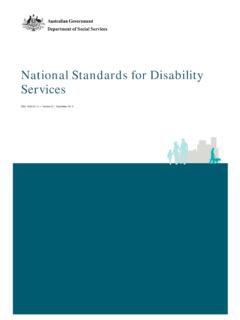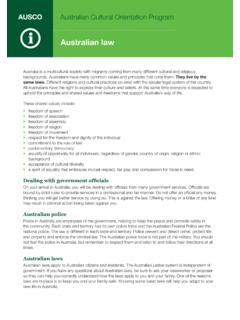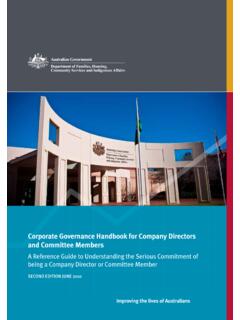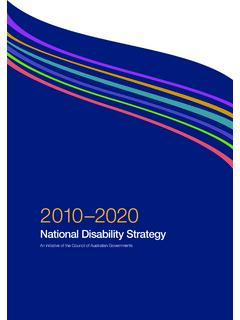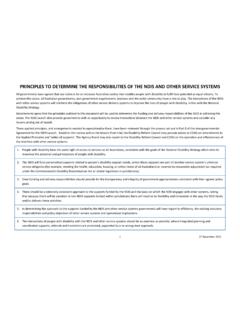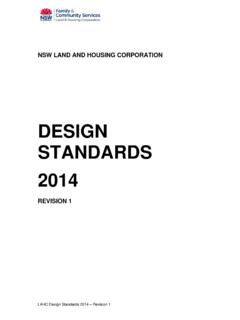Transcription of Livable Housing Design Guidelines - dss.gov.au
1 Livable Housing Design Guidelines Developed by the National Dialogue on Universal Housing Design Revision 1: May 2011 Page| 2 1 Contents What is Livable Housing Design ?.. 3 The Livable Housing Design 3 The relationship between the Livable Housing Design Guidelines and the Building Code of Australia (BCA).. 4 5 Key Design 6 1. Dwelling 2. Dwelling 3. Car parking (where part of the dwelling access)..8 4. Internal doors & 5. 6. 7. Reinforcement of bathroom & toilet 9. Laundry 10. Ground (or entry level) Bedroom 11. Internal 12. Switches and 13. Door and Tap 14. Family/Living room 15. Window 16. INFORMATIVE 22 34 Reproduction of 34 Page| 3 2 What is Livable Housing Design ? Livable Housing Design means designing Australian homes to meet the changing needs of occupants across their lifetime. It recommends the inclusion of key easy living features that aim to make homes easier and safer to use for all occupants including: people with a disability, ageing Australians, people with temporary injuries, and families with young children.
2 A Livable home is designed to: be easy to enter be easy to move around in be capable of easy and cost-effective adaptation, and be designed to anticipate and respond to the changing needs of home occupants. By including user-friendly Design features a Livable home Design seeks to enhance the quality of life for all occupants at all stages of their life. 3 The Livable Housing Design Guidelines The Livable Housing Design Guidelines have been developed to assist the residential building and property industry and governments. They may also provide useful information for consumers seeking to introduce Livable Design features into a new home and could be readily applied within an existing home. Three levels of performance are detailed in the Livable Housing Design Guidelines . These voluntary performance levels can be applied to all new detached and semi detached houses, terraces and townhouses (Class 1a) and new apartment dwellings (Class 2).
3 In the majority of circumstances the performance requirements are identical. It is noted that common areas for some Class 2 buildings will be covered by the Disability (Access to Premises Buildings) Standards 2010 when it comes into effect. The levels of performance range from basic requirements through to best practice in Livable home Design and are as follows: Silver Level Core Livable Housing Design elements Gold Level Enhanced standards for the core Livable Housing Design elements plus additional elements Platinum Level Some further enhanced standards for the core Livable Housing Design elements plus all remaining elements. In line with the current government approach to social1 and affordable2 Housing initiatives, higher levels of performance are proposed for all new Housing that receives government 1 Social Housing refers to an existing and changing portfolio of Housing that has been financed with public funds.
4 It is generally provided for low income renters in Housing need. 2 Affordable Housing refers to Housing that is provided at an affordable rent to low and moderate income renters. Affordable rent is charged at below the market rent rates. Page| 4 assistance or funding for construction. The milestones for social and affordable Housing are detailed in the National Dialogue for Universal Housing Design s Strategic Plan. Homes built to meet the Livable Housing Design Guidelines include six core Design elements: 1. A safe and continuous path of travel from the street entrance and/or parking area to a dwelling entrance that is level, 2. At least one level (step free) entrance into the dwelling, 3. Internal doors and corridors that facilitate comfortable and unimpeded movement between spaces, 4. A toilet on the ground (or entry) level that provides easy access, 5. A bathroom that contains a hobless (step free) shower recess, and 6.
5 Reinforced walls around the toilet, shower and bath to support the safe installation of grabrails at a later date. The core Design elements would not necessarily accommodate the needs and abilities of all home occupants. However, they are considered to be of most widespread benefit and use in the majority of circumstances. Importantly, by including the core Livable Housing Design elements, home occupants are provided with the opportunity to reduce or avoid the costs associated with retrofitting a home to improve access in future, should it be required. 4 The relationship between the Livable Housing Design Guidelines and the Building Code of Australia (BCA) The Building Code of Australia (BCA) sets out the legal construction requirements for all new building work in Australia. It includes performance requirements that must be achieved for each aspect of building construction. In designing a home that incorporates Livable Housing Design Guideline elements it is important to ensure that all buil ding work also complies with the relevant BCA requirements where they apply, particularly for: fire safety water proofing of wet areas (internal) weather proofing (external) termite protection window location and size floor surfaces in wet areas and on stairs.
6 Stairways Page| 5 5 Application The elements described in the Livable Housing Design Guidelines are applicable to the following classes of buildings as specified in the BCA. Class 1 one or more buildings, which in association constitute: Class 1a a single dwelling being: (i) a detached house; or (ii) one of a group of two or more attached dwellings, each being a building, separated by a fire resisting wall, including a row house, terrace house, town house or villa unit; or Class 1b: (i) a boarding house, guest house, hostel or the like; with a total area of all floors not exceeding 300 m2 measured over the enclosing walls of the Class 1b building; and in which not more than 12 persons would ordinarily be resident, which is not located above or below another dwelling or another Class of building other than a private (ii) 4 or more single dwellings located on one allotment and used for short term holiday accommodation.
7 Class 2 a building containing 2 or more sole occupancy units, each being a separate dwelling. Class 4 a dwelling in a building that is a class 5, 6, 7, 8 or 9 if it is the only dwelling in the building. Note: The Design levels described in this Guideline should only be applied to the parts of the building classes not covered by the Disability (Access to Premises Buildings) Standards. Page| 6 Key Design Elements 1. Dwelling access Performance statement: There is a safe and continuous pathway from the street entrance and/or parking area to a dwelling entrance that is level. Silver Level (a) Provide a safe and continuous pathway from: (i) the front boundary of the allotment; or (ii) a car parking space, where provided, which may include the driveway on the allotment, to an entrance that is level (step-free) as specified in Element 2. This provision does not apply where the average slope of the ground where the path would feature is steeper than 1:14.
8 (b) The path of travel as referred to in (a) should have a minimum clear width of 1000mm and (i) an even, firm, slip resistant surface; (ii) a crossfall of not more than 1:40; and (iii) a maximum pathway slope of 1:14. (Landings are to be provided at intervals as detailed in (2009) for gradients between 1:20 1:14).3 (c) A step ramp compliant with (2009) may be incorporated, with a landing at its head, and foot where there is a change in height of 190mm or less. The landings must have a length of at least 1200mm exclusive of the swing of the door or gate that opens onto them. Gold Level As for silver level except replace (b) with a minimum clear pathway width of 1100mm. Platinum Level As for silver level except replace (b) with a minimum clear pathway width of 1200mm provided from: (i) the front boundary of the allotment, and (ii) any car parking space, where provided, which may include the driveway on the allotment, to an entrance that is level (step-free) as specified in Element 2.
9 3 Full compliance with the requirements of is not required. Consideration could be given to ensuring that the Design does not preclude the installation of kerb guards, handrails and tactile ground surface indicators (TGSI s) in the future. 2. Dwelling entrance Performance statement: There is at least one level entrance into the dwelling to enable home occupants to easily enter and exit the dwelling. Silver Level (a) The dwelling should provide an entrance door with - (i) a minimum clear opening width of 820mm; See Figure 2(a) (ii) a level transition and threshold (maximum vertical tolerance of 5mm between abutting surfaces is allowable provided the lip is rounded or beveled); and (iii) reasonable shelter from the weather. (b) A level landing area of 1200mm x 1200mm should be provided at the level (step-free) entrance door. (c) Where the threshold at the entrance exceeds 5mm and is less than 56mm, a ramped threshold compliant with (2001) may be provided.
10 See Figure 1. (d) The level (step- free) entrance should be connected to the safe and continuous pathway as specified in Element 1. Note: The entrance must incorporate waterproofing and termite management requirements as specified in the BCA. Gold Level As for silver level except replace (b) with a level landing area of 1350mm x 1350mm and (a) (i) with minimum clear door opening width of 850mm. See Figure 2(b) Platinum Level As for silver level except replace (b) with a level landing area 1500mm x 1500mm and (a) (i) with a minimum clear door opening width of Figure 2(c) Page| 7 3. Car parking (where part of the dwelling access) Performance statement: Where the parking space is part of the dwelling access it should allow a person to open their car doors fully and easily move around the vehicle. Silver Level (a) Where the parking area forms part of the dwelling access the space should incorporate - (i) minimum dimensions of at least 3200mm (width) x 5400mm (length); (ii) an even, firm and slip resistant surface; and (iii) a level surface (1:40 maximum gradient, 1:33 maximum gradient for bitumen).



